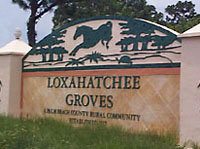The Loxahatchee Groves Intergovernmental Committee discussed several items Tuesday regarding coordination between the Town of Loxahatchee Groves and the Loxahatchee Groves Water Control District, particularly regarding planned canal work and cooperation on road fill.
LGWCD Administrator Steve Yohe said the canal work items were approved by the LGWCD board at its meeting on Monday.
“We wanted to certainly make the town aware of the intentions of the field work that we’re going to do besides just mowing and maintaining canals,” Yohe said.
The first was the relocation of an earthen guardrail at North A Road and North Road.
“This issue was the result of canal and road repair work conducted by district staff for FEMA due to the damage caused by Tropical Storm Isaac,” Yohe said. “District staff conducted emergency repair work on certain canal banks by replacing the earthen guardrails on top of the side of the OGEM pavement, thereby reducing the width of the road.”
Yohe said the work needs to be done before the anticipated resurfacing of the road in 2019.
“Though no road closing is anticipated, notification of the work will be provided to the town, the Loxahatchee Groves Landowners’ Association, the Palm Beach County Sheriff’s Office, Palm Beach County Fire-Rescue, Palm Beach County schools, and the schedule will be posted on the district’s web site,” Yohe said, adding that a flagman will be posted to help keep traffic flowing.
Town Council Liaison Councilman Todd McLendon asked whether the east canal bank will move, and Yohe said during Hurricane Irma, the canal level was lowered, revealing a shelf just below the water line about 2.5 feet wide.
“We’re going to have to build that up to the top to move this over,” Yohe said. “Fortunately, it’s not the entire road, and we have this issue also on North Road.”
He said the district will take any fill that is needed from a berm south of 160th Street that is taller than necessary.
“We’re not going to buy fill,” Yohe said. “We’re just going to truck it. We actually have a conveyor belt on the back of our dump truck that will shoot it over to the side. We think that is the most efficient way to get it done.”
Yohe said the project will be done in segments, and different techniques will be used to find the most efficient method, and they did not want to start by pushing the existing berm/guardrail into the canal, but build up the canal bank before pushing the existing berm over.
“Have you ever done this before?” asked LGWCD Supervisor Simon Fernandez, who chairs the committee.
“No,” Yohe said. “I’ve never heard of an earthen guardrail before.”
Yohe also discussed restoration of the North D Road canal.
Town Manager Bill Underwood asked whether the project included digging out the canal, and Yohe said it did.
“The roads need some building,” Underwood said. “Is that fill worth anything, rather than putting it on the west side of the canal?”
“It would be a lot easier if you could put it right on the road,” Yohe said. “The problem you have is it’s mud. It takes two months to dry out.”
Fernandez said it may be possible to use it after it dries out.
“After it dries out and you take the trash out of it,” he said. “Eventually we’re going to have enough fill to sell it.”
Yohe stressed that the town and district, through communication with the Intergovernmental Committee, had developed a dispensation policy that gives first priority to the town for fill.
“Given that we would even be a subsidiary to the town, that policy would be embraced by you and could be a lot easier,” Yohe said, adding that there is excess fill along most of the roads.
“That fill came from the canals themselves, and it’s good material if it’s cleaned of the garbage,” he said.
Underwood asked if a sifter could be used on the fill when it’s pulled from the canals, and McLendon asked if vacant land might be found near dirt roads that are below grade so that it could be spread after it dries out.
Yohe was reluctant to concede to a proposal that would require more labor and equipment by the district.
“We only have one dump truck,” he said. “Are you talking before you’re prepared to pave or… when you pave?”
“No, right now,” Underwood said.
“Before you put good material on top of it,” McLendon said.
Underwood said that some of the roads are 12 to 18 inches below the adjacent property.
“I’m just looking for fill to bring it up in some fashion,” Underwood said. “We would put that down and put something on top of it so that we start. I don’t know how much it would take, but if you have 18 inches and four miles, that’s a lot.”








